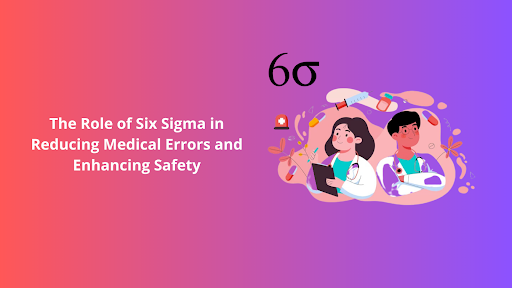Making sure patients are safe is of utmost significance. Medical mistakes can have disastrous effects on both patients and healthcare professionals. Six Sigma, a data-driven technique that focuses on process optimisation and waste reduction, has become a potent instrument in the fight against this serious problem. Healthcare organisations may adopt this technique to lower mistakes, improve safety, and ultimately deliver better patient care by undergoing the rigorous training provided by the Six Sigma Course.
Table of contents
- Understanding Six Sigma
- The Impact of Medical Errors
- Applying Six Sigma to Healthcare
- The DMAIC Approach in Healthcare
- Real-Life Success Stories
- Conclusion
Understanding Six Sigma
Six Sigma is a systematic methodology aiming to find and remove flaws, mistakes, or variances in operations to attain almost flawless performance. This system, which has its roots in the industrial sector, is now widely used in many industries, including healthcare. Achieving 3.4 faults per million chances, or a 99.99966% defect-free rate, is the main objective of Six Sigma. By using data-driven analysis, organisations may identify problem areas, streamline processes, and improve overall efficiency.
The Impact of Medical Errors
Any stage of the patient’s care, from diagnosis and therapy through drug administration and post-operative care, is susceptible to medical mistakes. These mistakes might result from poor communication, broken machinery, an absence of regular operating procedures, or human error. The effects might range from small issues to potentially lethal scenarios, necessitating prolonged hospital stays, higher medical expenses, and even fatalities. Healthcare practitioners must implement methods to reduce these hazards and prioritise patient safety.
Applying Six Sigma to Healthcare
Healthcare organisations may drastically lower the incidence of medical mistakes and improve patient safety by implementing Six Sigma concepts. Establishing quantifiable measures for patient care, such as prescription mistakes, surgical problems, or hospital-acquired infections, is the first step in the process. Healthcare personnel completing Six Sigma training will have the knowledge and abilities to gather and analyse data, pinpoint problem areas, and create efficient solutions.
The DMAIC Approach in Healthcare
- Define, quantify, examine, enhance, and control. This systematic strategy serves as a road map for procedure enhancement in healthcare settings.
- In this phase, healthcare teams pinpoint the issue they aim to solve and establish precise goals. For instance, they can set a deadline for cutting medicine administration mistakes by 50%.
- The gathering of data is essential for determining the scope of the issue. Accurate data enables teams to understand the gravity of the problem by revealing insights into the frequency and kind of mistakes.
- Data is analysed at this stage to pinpoint the reasons for mistakes. It aids healthcare personnel in identifying the causes of errors, such as a lack of training, ineffective processes, or communication gaps.
- Healthcare teams come up with and put into action solutions using the analysis’s results. This can entail simplifying staff training on new practices, implementing checklists, or streamlining communication routes.
- The gains made must be maintained and tracked during the final phase. Continuous observation guarantees that any deviations from the intended results are swiftly addressed and that the modifications will continue to work.
Real-Life Success Stories
Several healthcare organisations have already realised the benefits of using Six Sigma principles. For instance, by implementing Six Sigma into its operating room procedures, a hospital in New York successfully eliminated surgical site infections. Infection rates significantly dropped due to standardised protocols, appropriate equipment sterilisation, and staff training.
Conclusion
The quest for increased patient safety and decreased medical mistakes by the healthcare sector has led to Six Sigma methodology and courses emerging as crucial instruments. Healthcare organisations may reduce risks, improve patient care, and streamline procedures by analysing data and implementing data-driven solutions. In addition to saving lives, applying Six Sigma concepts in the medical profession helps create a future healthcare system that is more dependable and effective.


